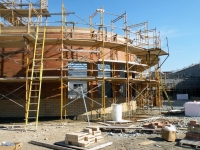
Buildipedia Staff
Dry-Pipe Sprinkler Systems
Mon, Aug 17, 2009Fire-Suppression Standpipes
Mon, Aug 17, 2009Facility Fire Hydrants
Mon, Aug 17, 2009Fire-Suppression Systems Insulation
Mon, Aug 17, 2009Trash Chutes
Mon, Aug 17, 2009Trash chutes evolved as a sanitary and economical means of collecting the refuse generated by building occupants in mid-rise and high-rise buildings.�The word chute is derived from the French word meaning to fall or drop. Chutes are tubes through which objects slide from a higher to a lower level by means of gravity. There are linen chutes used by hospitals and hotels; construction trash chutes used to handle construction debris in multi-story construction sites; and trash chutes used in multi-story condominiums, apartments, and dormitories.�In a trash chute application, the bottom of the chute below the discharge door is a steel container typically located in the trash room.�The steel container can be a fully automatic, hydraulically operated compactor or a small, simple cubic yard steel container.�Recent developments by many manufacturers have made possible a collection system that allows for the automatic separation and collection of recyclable materials.
Scaffolding
Tue, May 18, 2010Scaffolding has multiple functions and a variety of configurations, enabling it to meet the needs of virtually any construction or maintenance project. One function of a scaffolding system (sometimes referred to as staging) is to provide safe temporary access for workers and materials to an elevated area of a building, either interior or exterior, for construction, alteration, or routine maintenance or renovation activities. Scaffolding can also provide safe, temporary shoring for building materials and structural components. Scaffolding has evolved from the very early days of wooden and bamboo structures to sophisticated, and often elaborate, metal structures which require the services of a structural engineer. Without scaffolding, many construction and building repair activities would not be possible.
Wheelchair Lifts
Mon, Aug 17, 2009Wheelchair lifts, also referred to as platform lifts, are vertical elevating systems with a platform designed to transport a single passenger between floor levels. Some manufacturers provide units that can travel up to a maximum of 14 feet, but shorter vertical distances (less than one floor) are typical.�Wheelchair lifts are typically provided as a prefabricated, self-contained system that can be located indoors or outdoors. They can be installed in an enclosed vertical shaft to provide weather protection, if necessary, or they can be left unenclosed. Like traditional passenger elevators, the wheelchair lift system must meet all the requirements of the ADA.
Elevator Controls
Mon, Aug 17, 2009As the use of elevators has grown and their performance has been improved to provide safer, more dependable,�and more efficient travel for passengers in multi-story buildings, so too have elevator controls been improved. The operation of the modern-day elevator is very complex, involving strict safety requirements. As a part of an elevator's equipment, the controls must accommodate several types of passenger requirements: VIP service (firefighters and medical personnel), restricted access, non-stop service, and peak demand needs. Elevator controls also need to feature modes of operation for fire response and maintenance.
Hydraulic Elevators
Fri, Jun 11, 2010Hydraulic Elevators are prevalent in multi-level structures throughout the world. They facilitate and control the flow of people, make the movement of equipment easier, and allow disabled persons access to upper-level floors. Elevators in use today fall into three general categories: hydraulic, electric traction, and Machine Room-Less (MRL). The hoisting mechanisms to lift the cars of elevators generally employ either hydraulics or wire-rope traction systems. The principle of hydraulics is based on Pascal�s law of the incompressibility of fluids: any change in pressure applied at any point in the fluid is transmitted undiminished throughout. This pressurized fluid is used for the generation, control, and transmission of power.

